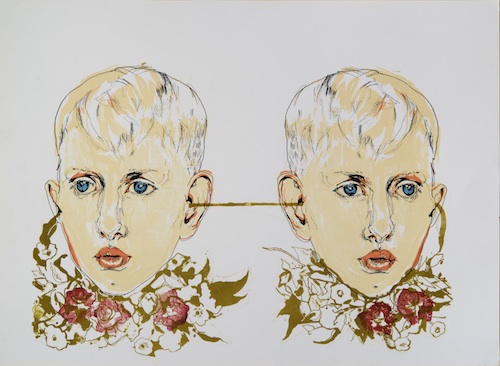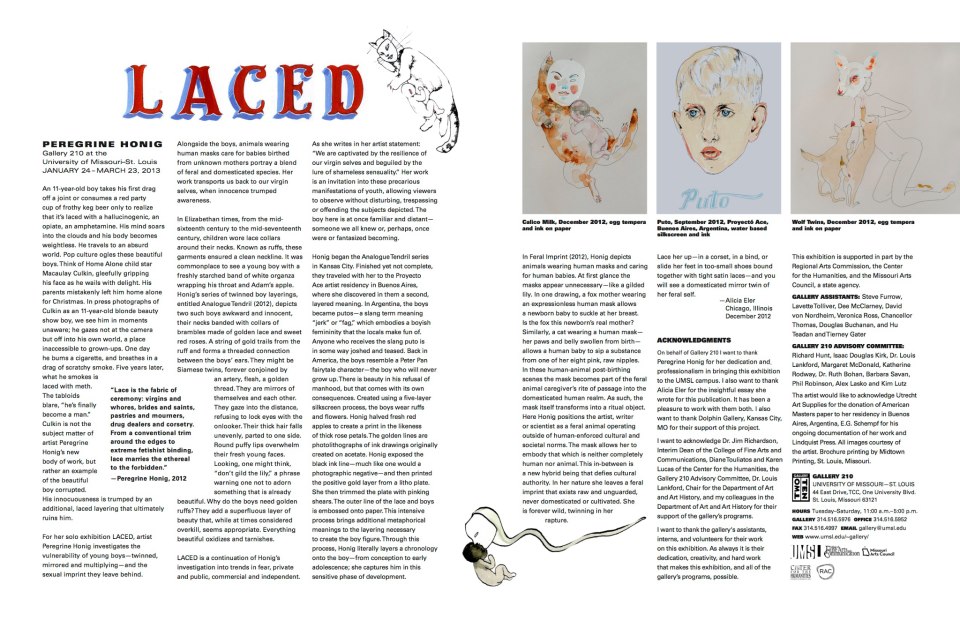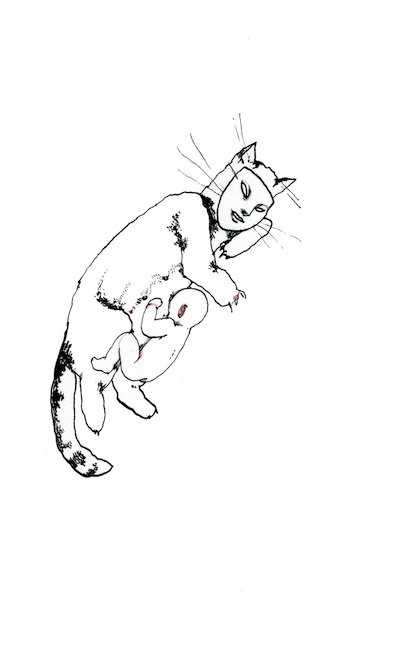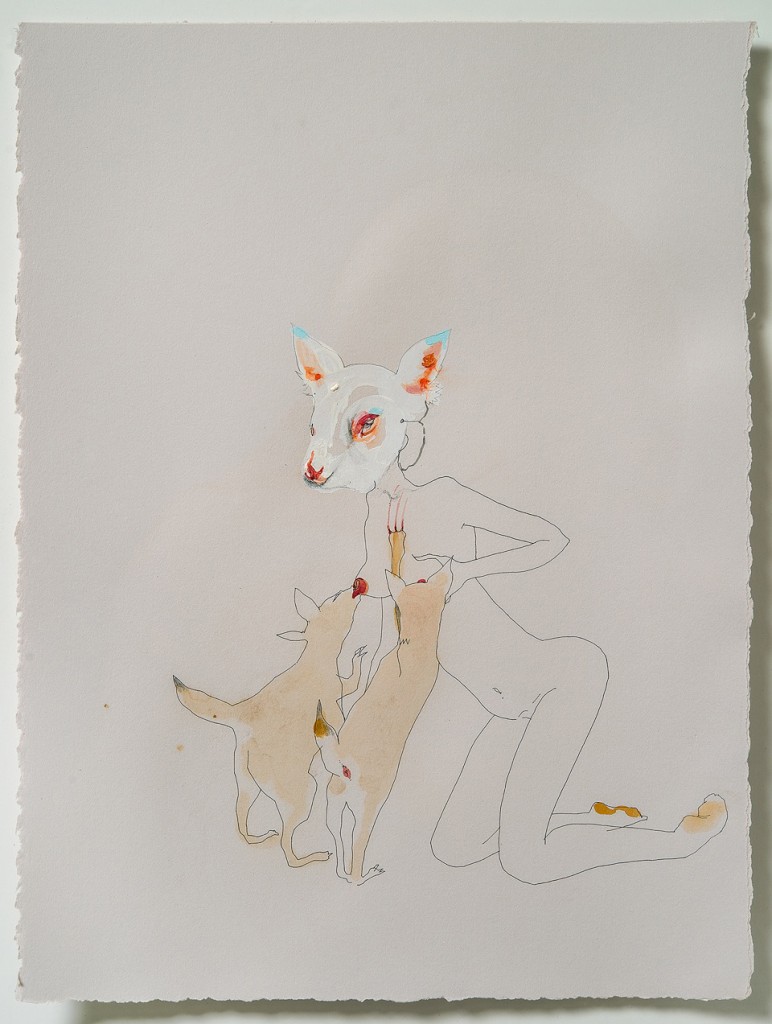Peregrine Honig
LACED
Gallery 210 at the University of Missouri–St. Louis
January 24–March 23, 2013
“Lace is the fabric of ceremony: virgins and whores, brides and saints, pastries
and mourners, drug dealers and corsetry. From a conventional trim around the
edges to extreme fetishist binding, lace marries the ethereal to the forbidden.”
—Peregrine Honig, 2012
An 11-year-old boy takes his first drag off a joint or consumes a red party cup of frothy keg beer only to realize that it’s laced with a hallucinogenic, an opiate, an amphetamine. His mind soars into the clouds and his body becomes weightless. He travels to an absurd world. Pop culture ogles these beautiful boys. Think of Home Alone child star Macauley Culkin, gleefully gripping his face as he wails with delight. His parents mistakenly left him home alone for Christmas. In press photographs of Culkin as an 11-year-old blonde beauty show boy, we see him in moments unaware; he gazes not at the camera but off into his own world, a place inaccessible to grown-ups. One day he bums a cigarette, and breathes in a drag of scratchy smoke. Five years later, what he smokes is laced with meth. The tabloids blare “he’s finally become a man.” Culkin is not the subject matter of artist Peregrine Honig’s new body of work, but rather an example of the beautiful boy corrupted. His innocuousness is trumped by an additional, laced layering that ultimately ruins him.
For her solo exhibition LACED, artist Peregrine Honig investigates the vulnerability of young boys—twinned, mirrored and multiplying—and the sexual imprint they leave behind. Alongside the boys, animals wearing human masks care for babies birthed from unknown mothers portray a blend of feral and domesticated species. Her work transports us back to our virgin selves, when innocence trumped awareness.
In Elizabethan times, from the mid-sixteenth century to the mid-seventeenth century, children wore lace collars around their necks. Known as ruffs, these garments ensured a clean neckline. It was commonplace to see a young boy with a freshly starched band of white organza wrapping his throat and Adam’s apple. Honig’s series of twinned boy layerings, entitled Analogue Tendril (2012), depicts two such boys awkward and innocent, their necks banded with collars of brambles made of golden lace and sweet red roses. A string of gold trails from the ruff and forms a threaded connection between the boys’ ears. They might be Siamese twins, forever conjoined by an artery, flesh, a golden thread. They are mirrors of themselves and each other. They gaze into the distance, refusing to lock eyes with the onlooker. Their thick hair falls unevenly, parted to one side. Round puffy lips overwhelm their fresh young faces. Looking, one might think, “don’t gild the lily,” a phrase warning one not to adorn something that is already beautiful. Why do the boys need golden ruffs? They add a superfluous layer of beauty that, while at times considered overkill, seems appropriate. Everything beautiful oxidizes and tarnishes.
LACED is a continuation of Honig’s investigation into trends in fear, private and public, commercial and independent. As she writes in her artist statement: “We are captivated by the resilience of our virgin selves and beguiled by the lure of shameless sensuality.” Her work is an invitation into these precarious manifestations of youth, allowing viewers to observe without disturbing, trespassing or offending the subjects depicted. The boy here is at once familiar and distant—someone we all knew or, perhaps, once were or fantasized becoming.
Honig began the Analogue Tendril series in Kansas City. Finished yet not complete, they traveled with her to the Proyecto Ace artist residency in Buenos Aires, where she discovered in them a second, layered meaning. In Argentina, the boys became putos—a slang term meaning “jerk” or “fag,” which embodies a boyish femininity that the locals make fun of. Anyone who receives the slang puto is in some way joshed and teased. Back in America, the boys resemble a Peter Pan fairytale character—the boy who will never grow up. There is beauty in his refusal of manhood, but that comes with its own consequences. Created using a five-layer silkscreen process, the boys wear ruffs and flowers. Honig halved fresh red apples to create a print in the likeness of thick rose petals. The golden lines are photo-lithographs of ink drawings originally created on acetate. Honig exposed the black ink line—much like one would a photographic negative—and then printed the positive gold layer from a litho plate. She then trimmed the plate with pinking shears. The outer line of the lace and boys is embossed onto paper. This intensive process brings additional metaphorical meanings to the layering necessary to create the boy figure. Through this process, Honig literally layers a chronology onto the boy—from conception to early adolescence, she captures him in this sensitive phase of development.
In Feral Imprint (2012), Honig depicts animals wearing human masks and caring for human babies. At first glance the masks appear unnecessary—like a gilded lily. In one drawing, a fox mother wearing an expressionless human mask allows a newborn baby to suckle at her breast. Is the fox this newborn’s real mother? Similarly, a cat wearing a human mask—her paws and belly swollen from birth—allows a human baby to sip a substance from one of her eight pink, raw nipples. In these human-animal post-birthing scenes the mask becomes part of the feral animal caregiver’s rite of passage into the domesticated human realm. As such, the mask itself transforms into a ritual object. Here Honig positions the artist, writer or scientist as a feral animal operating outside of human-enforced cultural and societal norms. The mask allows her to embody that which is neither completely human nor animal. This in-between is a new hybrid being that defies cultural authority. In her nature she leaves a feral imprint that exists raw and unguarded, never domesticated or cultivated. She is forever wild, twinning in her rapture. Lace her up—in a corset, in a bind, or slide her feet in too-small shoes bound together with tight satin laces—and you will see a domesticated mirror twin of her feral self.
—Alicia Eler
Chicago, Illinois
December 2012
To download a PDF of the catalogue essay: lacedcatalog
For more information on LACED: http://gallery210.umsl.edu/uncategorized/gallery-210-is-closed-from-november-19-through-november-26-for-the-thanksgiving-holiday/
To read more about Eler and Honig’s collaborations: https://aliciaeler.com/peregrine-honig/







